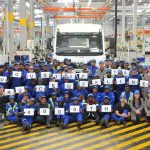The parable of the China dolls

Here’s a parable that helps to explain how transport in all its forms is actually letting down the South African economy
In addition to all the other shady deals, investigative journalists at amaBhungane have uncovered a cost overrun of R260 million on the class 20E, a dual-voltage electric locomotive forming part of the tender for 1 064 new locomotives for Transnet.
The class 20E consists of 95 locomotives. Numbered 20 001 to 20 095, they have all been delivered and are now in service. They are good locomotives – railway people affectionately call them “China dolls”. While some people dislike their boxy shape, I think they look great.
It’s what they actually do, however, that concerns me. Transnet Freight Rail uses 93 of them to move goods, mainly manganese and iron ore, on the line between Sishen and Port Elizabeth.
Coupled in groups of four, they shift 10 000 to 20 000 t of ore at a time. In the process, they earn handsome profits for the railway as well as good returns for the shareholders of the mine.
Sadly, along the way they pass through run-down towns and abandoned stations, many of which once provided employment for thousands of railway people. It was mainly low-level, but honest, work. It helped to keep people off the streets and away from the big cities.
The other two 20Es – numbers
20 031 and 20 032 – are painted blue and are used to pull the Blue Train between Cape Town and Pretoria. They are also doing a fine job – almost every time the train runs, someone posts a video on Facebook showing it passing through the Stilfontein area (another appropriately named ghost town).
On the days when they are in for servicing, normal red TFR locomotives are used, presenting a gaudy clash of colours, which doesn’t go down well with me and other rail fans.
So, where’s the parable? Whether pulling a passenger or a goods train, the “China dolls” are of little use to you or me. They are invisible to most South Africans unless they are on Facebook. If some 20Es could be used on a daily all-stops train to Cape Town, even if it takes 30 hours to get there, they would at least be of benefit to a lot more people.
Transport is merely helping to keep the economy in the doldrums. For moving freight, we use rail transport to sell our country for R10 a kilogram. Later, when we buy it back at R1 000 a kilogram, we use road transport.
You can’t blame transport for that, but when it comes to moving people, we use mini Sherman tanks to carry one and a half people at a time. That’s far more serious, and something has to give.
We are in an economic mess and instead of reducing the fuel price we should be talking about rationing the stuff. Think Cape Town; water; expropriation without compensation.
We need a new academic discipline for transport – existing qualifications are near-useless. Up to now, individual professions have been messing it up. The engineers merely want to pour concrete everywhere. The accountants and auditors sign off on figures that hide massive underperformance.
The sociologists and economists come up with meaningless surveys, telling us that left-handed people prefer riding upstairs in the bus and that cat lovers prefer sitting on the left-hand side of the train.
So perhaps we should rather call the boxy “dolls” “China brics”, if only to remind ourselves that South Africa is some way behind its Brics partners (made up of Brazil, Russia, India, China and South Africa) when it comes to passenger transport.
Published by
Vaughan Mostert
focusmagsa




